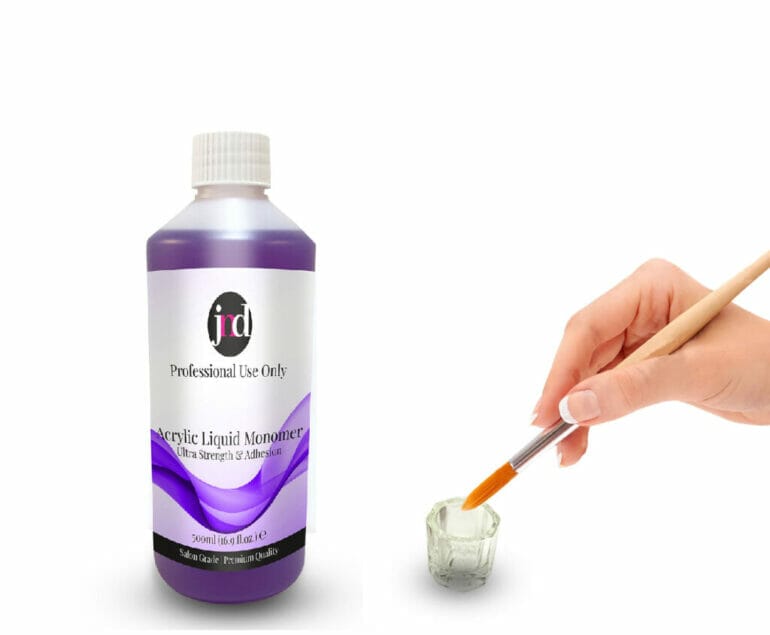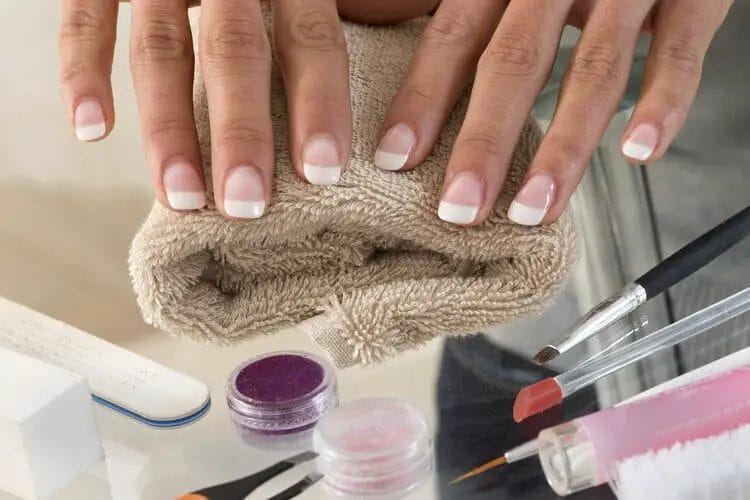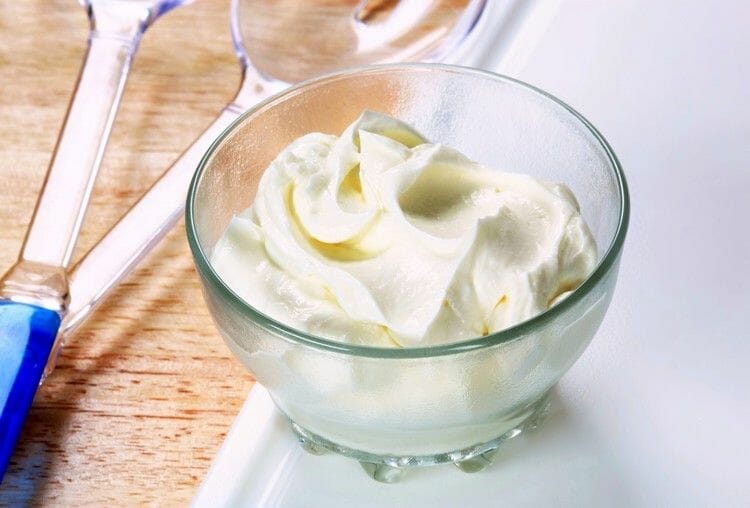If you’re looking for an alternative to acrylic liquid, there are a few options to consider. One popular choice is using a gel polish system, which offers a similar level of durability and shine. Another option is using a dip powder system, where you dip your nails into a colored powder and then seal it with a top coat. Lastly, you can also try using builder gels, which provide a strong and long-lasting foundation for your manicure. Each alternative has its own unique benefits, so it’s worth exploring which one works best for you.

Substitutes for Acrylic Liquid in Nail Enhancements
In the world of nail enhancements, acrylic liquid is a key component that helps create strong and durable artificial nails. However, there may be instances where you find yourself without acrylic liquid or simply looking for an alternative. In this section, we will explore some substitutes for acrylic liquid in nail enhancements.
1. Acetone
Acetone, a common ingredient found in nail polish removers, can be used as a substitute for acrylic liquid. It acts as a solvent, breaking down the acrylic powder and turning it into a paste-like consistency. While acetone can be effective, it may not provide the same level of strength and durability as traditional acrylic liquid. Additionally, acetone has a strong odor and can be drying to the nails and surrounding skin.
2. Isopropyl Alcohol
Isopropyl alcohol, also known as rubbing alcohol, is another substitute that can be used in a pinch. Like acetone, it can dissolve acrylic powder and help create a workable paste. However, it is important to note that isopropyl alcohol may not provide the same level of adhesion and durability as acrylic liquid. It is also important to use a high percentage of isopropyl alcohol to ensure proper dissolution of the acrylic powder.
3. Monomer Alternatives
There are also monomer alternatives available in the market that can be used as substitutes for acrylic liquid. These products are specifically formulated to provide similar properties as acrylic liquid, such as adhesion and durability. They are often odorless and have less drying effects on the nails and skin. Some popular monomer alternatives include polygel and gel systems.
4. Nail Glue
In certain situations, nail glue can be used as a temporary substitute for acrylic liquid. Nail glue is typically used for attaching artificial nails or repairing broken nails. While it can provide some adhesion, it is important to note that it may not offer the same level of strength and durability as acrylic liquid. Nail glue should be used cautiously and sparingly, as excessive use can damage the natural nails.
5. Fiberglass or Silk Wraps
If you are looking for alternatives to traditional acrylic liquid, you may consider using fiberglass or silk wraps. These materials can be used to strengthen and reinforce the natural nails without the use of liquid monomer. Fiberglass or silk wraps are applied onto the nails with an adhesive and then sealed with a topcoat. While they may not provide the same level of thickness or durability as acrylic enhancements, they can be a good option for those looking for a more natural and flexible solution.
In summary, while acrylic liquid is a commonly used component in nail enhancements, there are several substitutes available that can be used in its absence. Acetone, isopropyl alcohol, monomer alternatives, nail glue, and fiberglass or silk wraps are all viable options depending on your specific needs and preferences. It is important to note that these substitutes may not offer the same level of strength and durability as acrylic liquid, so it is best to consult with a professional nail technician for guidance and proper application.

Non-Acrylic Options for Nail Extensions
When it comes to nail extensions, acrylic nails have long been the go-to option for many. However, if you’re looking for an alternative to acrylics, there are several non-acrylic options available that can give you beautiful, long-lasting nails. In this section, we will explore some of the popular non-acrylic options for nail extensions.
1. Gel Nails
Gel nails have gained immense popularity in recent years as an alternative to acrylics. This type of nail extension involves applying a gel-like substance over your natural nail and then curing it under a UV or LED lamp. Gel nails offer a natural and glossy finish that mimics the look of real nails. They are also known for their durability and flexibility, making them less prone to cracking or breaking compared to acrylics.
With gel nails, you have the option to choose between hard and soft gels. Hard gel is more suitable for those who want to add length and structure to their nails, while soft gel is ideal for overlaying on natural nails to provide extra strength and protection.
2. Fiberglass Nails
Fiberglass nails are another non-acrylic option for nail extensions that have gained popularity among nail enthusiasts. This method involves the use of fiberglass wraps or mesh to reinforce the natural nail and provide a base for the extension. The fiberglass is applied using a resin adhesive, creating a strong and durable layer that can be shaped and buffed to perfection.
One of the major benefits of fiberglass nails is their lightweight nature. They feel more natural and less bulky compared to acrylics, making them a comfortable option for everyday wear. Fiberglass nails are also known for their flexibility, allowing them to withstand impact and bending without easily breaking.
3. Polygel Nails
Polygel nails are a relatively new addition to the world of nail extensions and have quickly gained popularity for their versatility and ease of application. Polygel is a hybrid nail enhancement product that combines the best features of both gel and acrylic systems.
Unlike traditional acrylics, polygel does not require the use of monomers or multiple steps. It comes in a convenient tube, with a putty-like consistency that can be easily shaped and molded. Polygel is then applied directly on the natural nail or an extension form and cured under a UV or LED lamp.
What sets polygel apart is its lightweight and flexible nature. It offers a comfortable and natural feel while still providing strength and durability. Polygel nails are also highly resistant to lifting, cracking, and chipping, making them a long-lasting option for nail extensions.
While acrylic nails have long been the standard for nail extensions, there are plenty of non-acrylic options that can give you stunning and durable nails. Gel nails, fiberglass nails, and polygel nails are just a few of the popular alternatives available. Each option offers its own unique benefits, allowing you to find the perfect fit for your desired look and lifestyle. Whether you’re looking for a natural and glossy finish or a lightweight and flexible extension, non-acrylic options have you covered.

Popular Replacements for Acrylic Liquid
Acrylic liquid is a common component used in the application of acrylic nails. However, some people may have sensitivities or allergies to acrylic liquid, or they may prefer to use alternative products. In this section, we will explore some popular replacements for acrylic liquid that are widely used in the nail industry.
1. UV Gel
UV gel is a popular alternative to acrylic liquid. It is a type of gel that is cured under a UV or LED lamp. UV gel is known for its durability and long-lasting finish. It is available in various viscosities, allowing nail technicians to create different levels of thickness and flexibility. UV gel is also available in a wide range of colors and finishes, making it a versatile option for nail art.
2. Polygel
Polygel is a newer innovation in the world of artificial nails. It is a hybrid product that combines the qualities of both acrylic and gel. Polygel is typically applied using a tube or syringe, making it easy to control and shape. It does not require monomer or liquid to activate, making it an ideal option for those who are sensitive to acrylic liquid. Polygel also offers a lightweight and flexible feel, similar to natural nails.
3. Dip Powder
Dip powder is another popular alternative to acrylic liquid. It involves dipping the nails into a colored powder, which is then sealed with a clear topcoat. Dip powder provides a strong and durable finish, similar to acrylic nails. It is available in a wide range of colors and can also be used to create various nail designs. Dip powder is known for its quick and easy application process, making it a popular choice among both professionals and DIY nail enthusiasts.
4. Fiberglass Wraps
Fiberglass wraps are thin sheets of fiberglass that are applied to the natural nail to add strength and durability. Unlike acrylic liquid, fiberglass wraps do not require any liquid or monomer for application. The wraps are typically applied using a resin or adhesive, which is then cured under a UV or LED lamp. Fiberglass wraps can be used to repair broken or damaged nails, as well as to extend the length of the natural nail.
In summary, there are several popular replacements for acrylic liquid in the nail industry. UV gel, polygel, dip powder, and fiberglass wraps are all viable options for those who are looking for alternatives to traditional acrylic nails. Each option offers its own unique features and benefits, allowing individuals to achieve the desired look and durability for their artificial nails.
Exploring Different Liquids for Nail Art and Extensions
In the world of nail art and extensions, there are various liquids that play a crucial role in achieving the desired results. These liquids not only enhance the appearance of the nails but also contribute to their durability and longevity. In this section, we will explore different liquids used in nail art and extensions and understand their significance.
1. Nail Polish
Nail polish is a liquid product that adds color and shine to the nails. It is available in a wide range of shades and finishes, allowing individuals to express their creativity and style. Nail polish typically contains a mixture of solvents, resins, and pigments. The solvents help the polish to dry quickly and adhere to the nails, while the resins provide durability. Nail polish is an essential liquid for nail art as it forms the base for various designs and patterns.
2. Nail Primer
Nail primer is a liquid used to prepare the natural nail surface before applying artificial extensions. It helps to remove any oils or moisture from the nails, ensuring better adhesion of nail enhancements. Nail primers usually contain methacrylic acid or acid-free formulations, depending on the type of nail system being used. Proper application of a nail primer is vital for preventing lifting or peeling of artificial nails.
3. Nail Dehydrator
A nail dehydrator is another important liquid used in nail art and extensions. It is applied after the nail primer to further remove moisture from the nail plate. Nail dehydrators often contain solvents like acetone or isopropyl alcohol, which help in eliminating any remaining oils or residue. By dehydrating the nail, the dehydrator ensures better adhesion of nail enhancements and reduces the risk of bacterial growth.
4. Nail Adhesive
Nail adhesive, also known as nail glue, is a liquid used to bond artificial nails to the natural nail surface. It is commonly used in nail extensions and nail art designs that require the use of tips or forms. Nail adhesives are typically cyanoacrylate-based, providing a strong and secure bond. It is essential to apply nail adhesive carefully to prevent air bubbles or uneven application.
5. Nail Cleanser
After the completion of nail art or extensions, a nail cleanser is used to clean the nails and remove any residue. Nail cleansers are formulated to remove excess oils, dust, and debris from the nail surface, leaving a clean and polished finish. They often contain ingredients like ethanol or isopropyl alcohol, which provide antiseptic properties and ensure the nails are free from any impurities.
6. Top Coat
A top coat is a liquid applied as the final step in the nail art or extension process. It adds a protective layer to the nails, sealing in the design and providing a longer-lasting finish. Top coats are available in different formulas, such as glossy, matte, or gel-like finishes. They help to prevent chipping, enhance shine, and extend the life of the nail art or extensions.
7. Cuticle Oil
Although not directly involved in the application of nail art or extensions, cuticle oil is a valuable liquid for maintaining the health and appearance of the nails. It nourishes the cuticles, keeping them moisturized and preventing dryness or peeling. Cuticle oil is typically a blend of natural oils like jojoba, almond, or vitamin E oil. Regular application of cuticle oil promotes healthy nail growth and improves the overall look of manicured nails.
In summary, the usage of various liquids in nail art and extensions is essential for achieving beautiful and long-lasting results. From nail polish to cuticle oil, each liquid serves a specific purpose in enhancing the appearance and durability of the nails. Understanding the significance and proper application of these liquids is crucial for nail technicians and enthusiasts alike.
FAQs
1. What can you use instead of acrylic liquid?
You can use different alternatives to acrylic liquid, such as monomer-free acrylic systems, gel systems, or dip powder systems.
2. How long does acrylic liquid take to dry?
Acrylic liquid typically takes around 2-3 minutes to dry, depending on the brand and the environment’s humidity.
3. Can you mix different brands of acrylic liquid and powder?
It is generally not recommended to mix different brands of acrylic liquid and powder, as they may have different formulations and could result in an inconsistent application and wear.
Conclusion
In conclusion, if you are looking for alternatives to acrylic liquid, there are a few options available. One popular alternative is using a gel or polygel system. These systems provide similar results to acrylics and offer added benefits such as easier application and less odor. Another option is dipping powder, which involves dipping the nails into a colored powder to create a durable and long-lasting manicure. Lastly, water-based nail polishes are a great alternative for those seeking a non-toxic and eco-friendly option. With these alternatives, you can still achieve beautiful and durable nail enhancements without using acrylic liquid.
